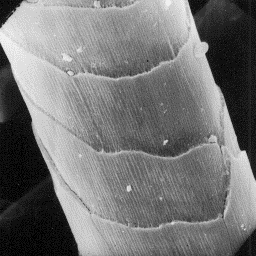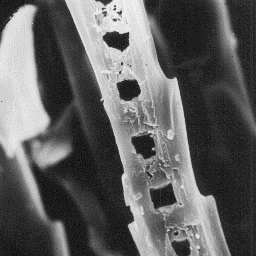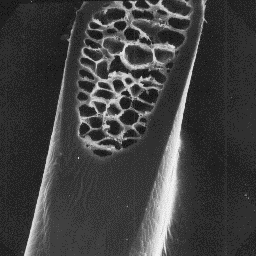 Mustela erminea
Mustela erminea
---------------
English: Stoat, weasel
German: Hermelin
French: Hermine
Spanish: Armino
Distribution areas
------------------
Stoat skins are obtained from weasel
which is found in Europe, in areas to the
north of the Pyrenees and in near and
middle Asia. Other weasel varieties are
found in the American continent and in the
Far East. About nine species of the animal
are known. The surface structure
of the skin, 60x
Description of the fur
----------------------
The skins of the stoat are from 15 to 30 cm long; the tail is about 10 to
15 cm long. The tip of the tail is black. The summer coat is yellow-brown or
red-brown with white spots on the throat, belly and on the inside of the
legs. The winter coat is denser and is white.
|
|
 Mustela erminea
Mustela erminea
---------------
English: Stoat, weasel
German: Hermelin
French: Hermine
Spanish: Armino
Structure of the hair
---------------------
The microscopic structure of the skin
surface is furrowed; the follicles are
narrow with straight edges. The number of
hair shafts in each follicle is from 5 to
20.
The fine fur fibres are circular in The cuticular structure
cross-section at the bottom of the shaft of an intermediate hair, 600x
but, in the middle and upper parts, the
outline is straight-sided. The diameter of the fine fibres is in the range of
5 to 15 µm. The cuticular scales are petal-like, with the exception of the
bottom pacts of the shafts, where they are cornet-like. The scale surface is
regularly grooved and the margins are straight. The medulla is wide, unbroken
and central symmetrical-shaped in cross-section. The overall medullar struc-
ture belongs to the uniserial ladder type with and amorphous infilling
material.
|
|
 Mustela erminea
Mustela erminea
---------------
English: Stoat, weasel
German: Hermelin
French: Hermine
Spanish: Armino
The intermediate fibres have a diameter
of 15 to 35 µm. The cross-sectional outline
is ellipsoidal and the cuticle is covered
by comb-like scales. In the lower parts,
the chafts have cuticular scales of an even
tile-like or rounded tile-like shape. The
cuticular scale surface is usually smooth
but, in the lower parts, the shafts are
covered by regularly grooved scales. The The cuticular structure
scale margins are straight.cThe medulla is of a guard hair, 4000x
wide, longitudinally unbroken and central
symmetrical-shaped in cross-section. The overall medullar structure belongs
to the lattice type with a sheet-like infilling material.
The guard hairs have a diameter in range of 35 to 115 µm. The
cross-sectional outline is ellipsoidal, except close to the skin surface
where the shafts have a circular cross-section. The cuticular scales are even
tile-like or, in the uppermost parts of the shact, crenated tile-like in
shape.
|
|
 Mustela erminea
Mustela erminea
---------------
English: Stoat, weasel
German: Hermelin
French: Hermine
Spanish: Armino
The scale surface is smooth or, at the
bottom of the fibres, grooved. The scale
margins are rippled and, in some fibres,
straight. The medulla is the same as that in
the intermediate fibres.
Longitudinal section
of a fine fur fibre, 2000x
|
|
 Mustela erminea
Mustela erminea
---------------
English: Stoat, weasel
German: Hermelin
French: Hermine
Spanish: Armino
Transverse section
of a guard hair, 400x
Numerical code for weasel skin structure
----------------------------------------
Surface of the skin: 3-4-3
Fine fur fibres: 6.1-5.11-2-1-2-1-1-1-8-5.15-3.14
Intermediate fibres: 2-2.3-1.2-1-2-1-1-8-1-15.35-7.15
Guard hairs: 2.1-2.4-2.1-2.1-2-1-1-8-1-35.115-15.22
|




